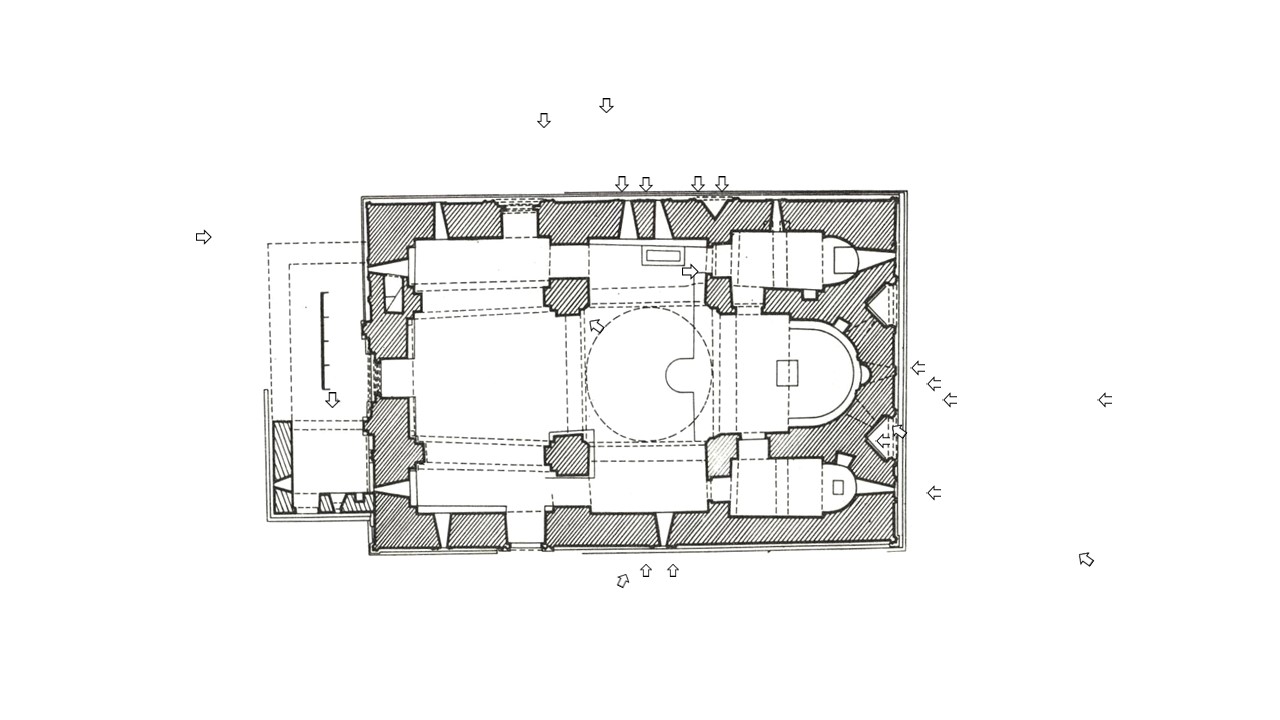Nato Chitishvili
The name Ertatsminda derives from the name of the patron of the church, St Eustate Placidas. The exact date of the church is unknown as there are no inscriptions or other written evidence. The earliest document to mention the church of Ertatsminda, a charter of the donation of lands, is dated to 1588. Based on architectural and stylistic analysis, the church is likely to have been built in the first half of the 13th century, during the reign of Queen Rusudan (1223-1245).
Queen Rusudan was a daughter of Queen Tamar and after the untimely death of her brother George IV in 1223, which marked the end of the Georgian Golden Age, she became the ruler of the country. Shortly after her accession to the throne in 1225, Georgia was attacked by the Khwarezmian shah, Jelal ad-Din, followed by the Mongols to whom Georgia surrendered without any serious resistance and by 1240 all of the country was under Mongol rule. In 1223 Queen Rusudan married the Seljuk prince Ghias ad-din, a grandson of Kilij Arslan II, whose father was an emir of Erzurum. From this marriage were born David Narin, future king of western Georgia, and a daughter, Tamar, known also as a Gurji Khatun, who was the wife of the sultan of Rum, Kaykhusraw II and the mother of sultan Kayqubad II.
Over the centuries the church of Ertatsminda has been restored several times. The main restoration was carried out at the end of the 14th century when a new dome was built. During this restoration instead of the original twelve windows in the drum supporting the dome, which were typical for 12th-13th century architecture, only eight narrow windows were cut.
The interior of the church is partially painted. According to the inscription above the door of the pastophories, the paintings were carried out during the reign of King Rostom and his wife queen Mariam in 1654, by the monk Meletios from the church of the Holy Cross in Jerusalem. On the north-eastern wall of the church, scenes from the life of St Eustatios are depicted. On the south-eastern wall are found scenes from the life of St George.
In terms of planning, this is a typical inscribed-cross type of church where the dome rests on two free standing piers to the west and on projections of the apse walls to the east. The church of Ertatsminda is a church which can be described as having an eclectic design, whereby different architectural elements were taken from different periods. One clear example of reminiscence are the lunettes used in the interior of the church above the west and north entrances, which from the outside have the form of a tympanum. The lunette was widespread through the early medieval period (Bolnisi, Anchiskhati) and it was a functional architectural element through which the interior of the church was lighted. After the 7th century this architectural element was abandoned by Georgian architects and centuries later it appeared again in Ertatsminda and in the church of Metekhi in Tbilisi (1278-1289). At Ertatsminda they do not function as a source of light, however, they are just part of the interior decoration.
The main element of the façade decoration of the church is the double-window with richly ornamented frames and the ornamented cross between them, which was a widely established theme among churches built in 12th and beginning of the 13th centuries. But, by the second half of the 13th century this element disappeared from façades.
The ornamental motifs used at Ertatsminda were well known in the first half of the 13th century. Alongside the ornamentation are figurative reliefs: on the east façade of the church a relief portrays the patron of the church, St Eustatios out hunting, when he was converted to Christianity. There are also two small images of horses. On the south façade there is a relief of a master builder who holds a tool in his hand.
What is noteworthy at Ertatsminda is a heart-shaped ornament that runs along the cornice on the north and east façades. There is no parallel for this pattern in Georgian architecture. Some churches in Georgia attempted to create a different kind of façade design in the 12th and 13th centuries. These solutions were probably based on well-known arcades and instead of using a simple semicircular arch, the architects tried to use a more complex form of arch. For instance, at Qvatakhevi church we see the combination of a stair-like pattern with a semicircular arch and at Khobi church the façade is decorated only with a stair-like “arch” which is doubled on the lower part of the wall; the same stair-like pattern is still visible at Metekhi church in Tbilisi. Thus at Ertatsminda this element might be considered as an example of this tendency, which did not develop or spread further. In terms of other similarities of pattern the exact same element can be seen on the façades of the masjid of Sultan Han (1232-1236), but in this case the heart-shaped ornaments terminate in dragon’s heads and they have not only a decorative function, but also symbolic or ideological connotations.
The church contains one relic of historical significance – the head of Paata Saakadze. He was the son of the politician and military commander Giorgi Saakadze, who played an important but controversial role in early 17th century Georgia. The Persian Shah Abas II beheaded his son, who was at the Persian court as a hostage and sent him his head, which was buried in this church. From that period on the church served as the family burial place for the descendants of Giorgi Saakadze.
Interactive Plan

Image Gallery
Bibliography
- Gomelauri, Ertatsmindis Tadzris Arqiteqtura (Tbilisi, 1976) (in Georgian).


